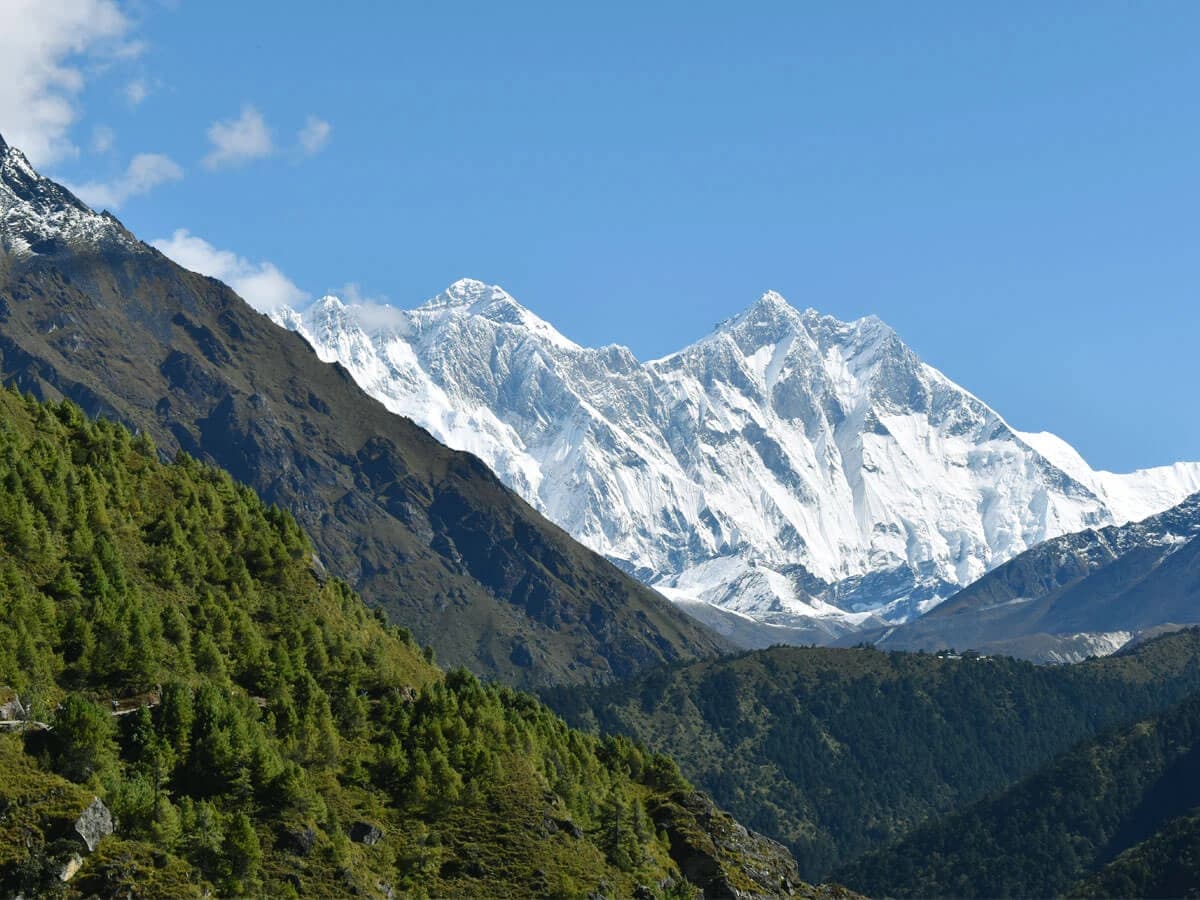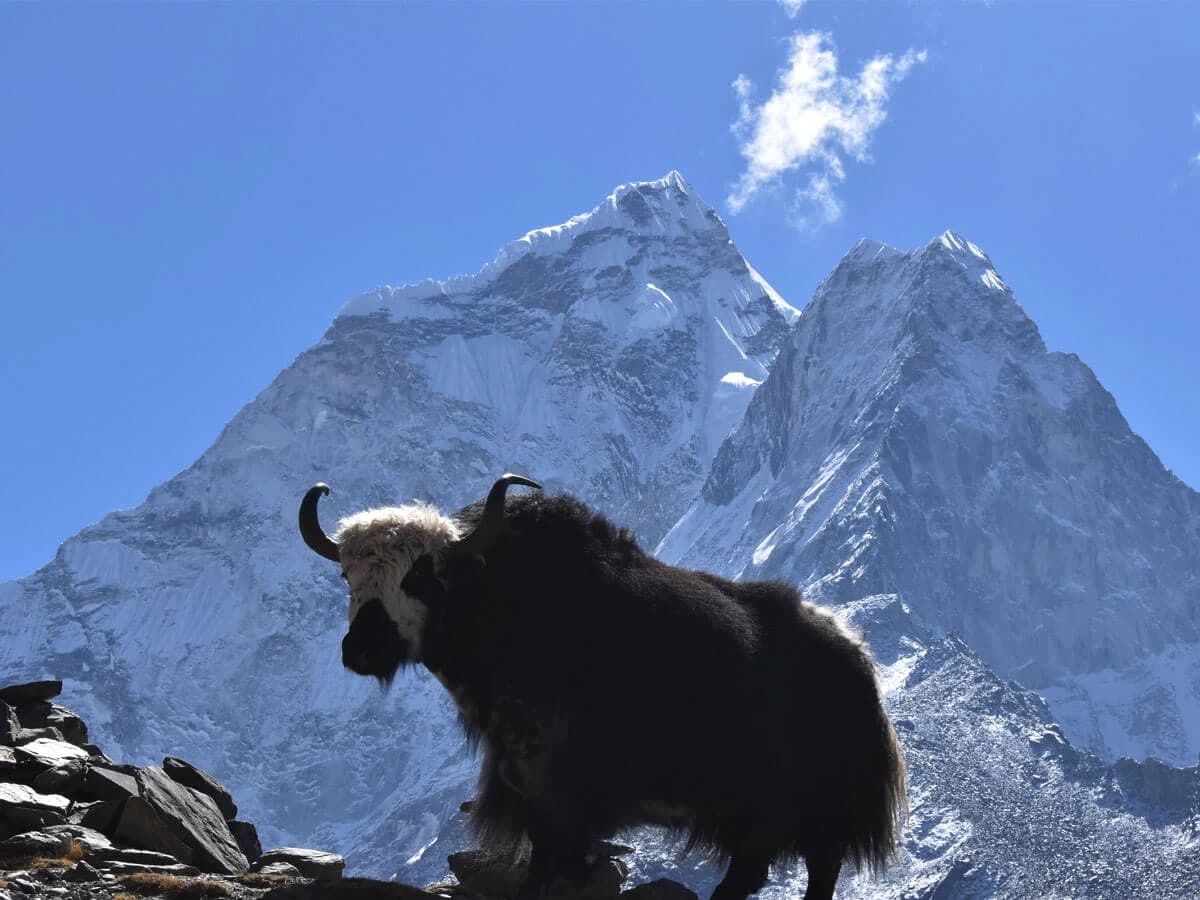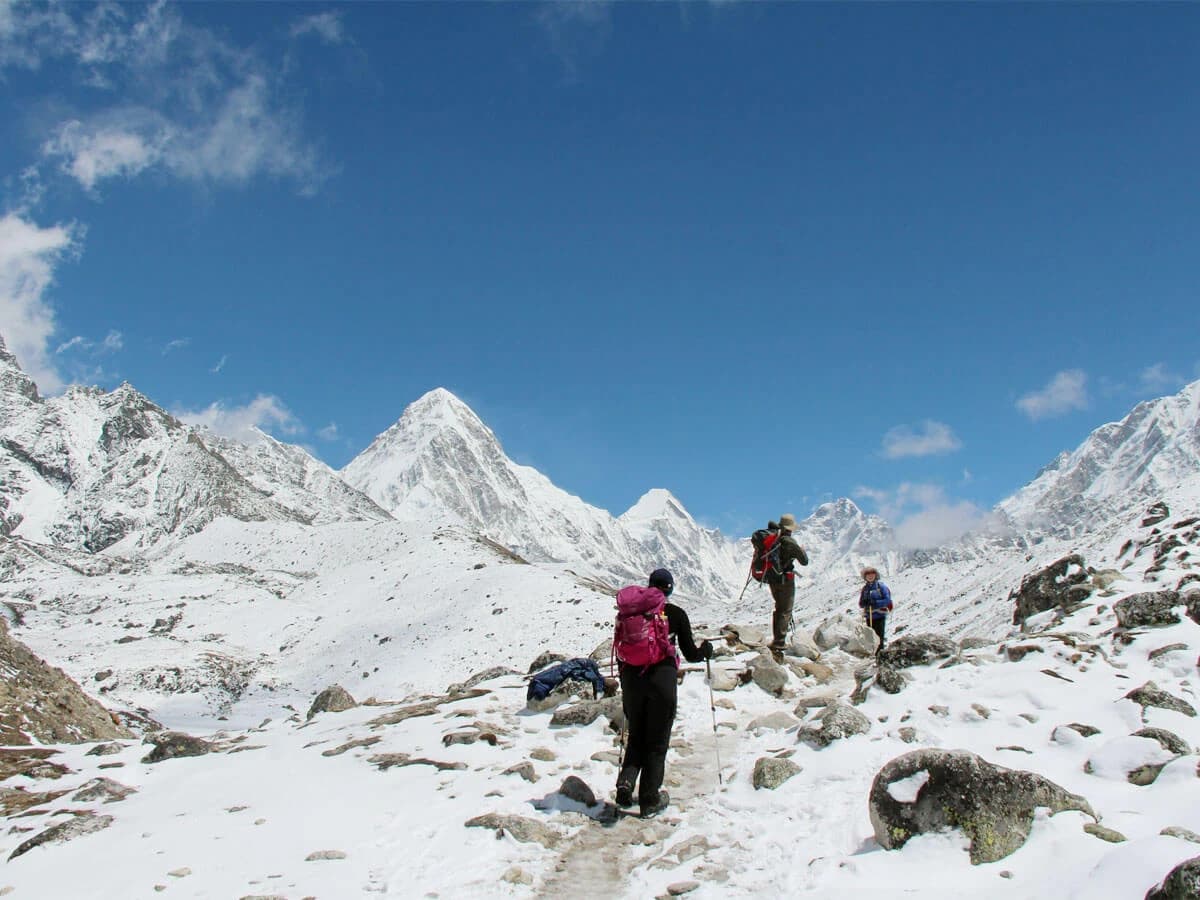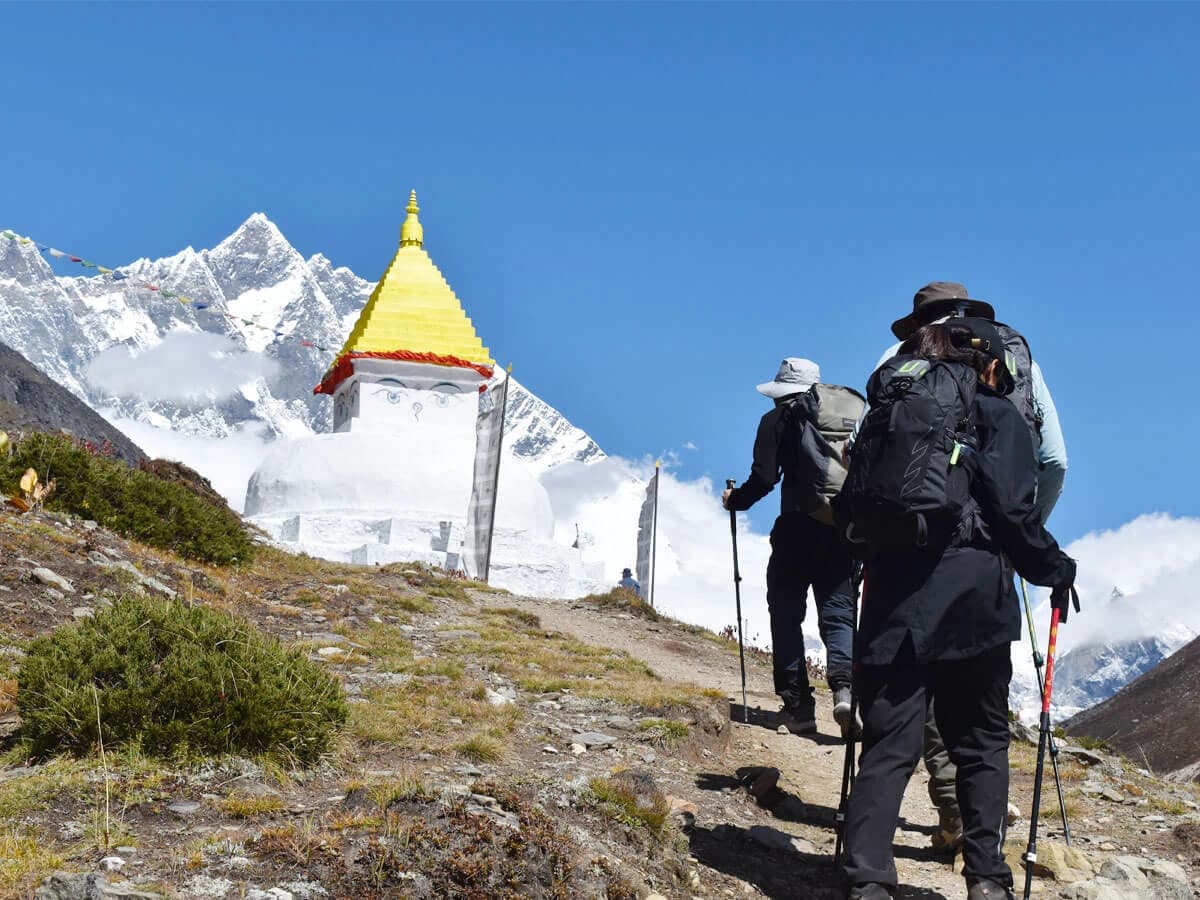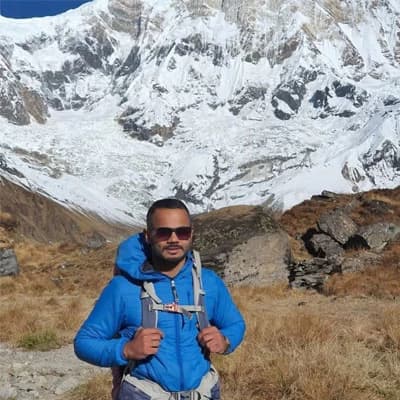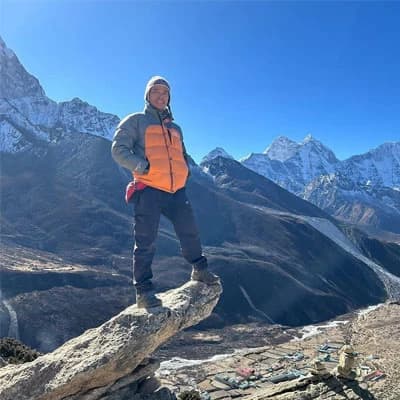The Everest Base Camp Trek is a 130 km long, 14-day journey to the base camp of the world’s highest peak, Mt. Everest. The picturesque trail rich in biodiversity enters the Sagarmatha National Park from Monjo and passes through beautiful Sherpa settlements of Tengboche, Dingboche, Gorakshep, and more. The trek to Everest starts at an elevation of 3,440 m/11,286 ft in Namche and goes as high as Kala Patthar at 5,644 m/18,517 ft.
Everest Base Camp Trek
Trip Highlights
- Take an unforgettable flight to Lukla and land at one of the most thrilling airports in the world.
- Cross exciting suspension bridges, all decked out in colorful prayer flags.
- Soak in the lively atmosphere of Namche Bazaar, where you’ll get a taste of Sherpa culture.
- Get ready to be awestruck by jaw-dropping views of Everest, Ama Dablam, Lhotse, and other towering peaks.
- Visit Tengboche Monastery, the heart of the region’s spiritual life.
- Step into Sagarmatha National Park, a UNESCO World Heritage site.
- Stand at Everest Base Camp, feeling the incredible energy of being at the foot of the world’s tallest mountain.
- Hike up to Kala Patthar and catch one of the most amazing sunrises you’ll ever see, with Everest shining brightly in the background.
- Walk past the awe-inspiring Khumbu Glacier and Icefall, nature’s true masterpieces on the way to Base Camp.
- Relax in cozy tea houses along the trail, where the warm hospitality of the Sherpa people makes you feel right at home.
- Trek through an ever-changing landscape, from lush forests to rocky alpine terrain.
- Push your limits on this high-altitude adventure, reaching up to 5,545m at Kala Patthar and soaking in the stunning scenery.
14-Day Trek to Everest Base Camp Overview
For those with a true spirit of adventure, the Everest Base Camp Trek is a journey of self-discovery, endurance, and awe-inspiring landscapes.
Your journey begins in the vibrant town of Lukla, where the excitement of the trek sets the tone for the days ahead. From here, you will wind your way through Sherpa villages, lush forests, and ancient monasteries, each step bringing you closer to the towering peaks of the Khumbu region.
As you trek, you’ll pass through the renowned Namche Bazaar, the beating heart of the Everest region, and go further to witness the serenity of Tengboche Monastery. Along the way, the ever-present peaks of Everest, Lhotse, and Ama Dablam seem to watch over you, their majestic presence serving as a reminder of the immensity of your journey.
Gorak Shep, a remote settlement nestled beneath the towering peaks, serves as the final stop before reaching Base Camp. From here, the path leads to Everest Base Camp itself. At this iconic destination, you will stand in awe before the mighty Khumbu Icefall and the towering Everest massif. Standing at the foot of Everest, with the Khumbu Icefall before you, is a moment of pure awe.
For those seeking a panoramic view like no other, a final ascent to Kala Patthar awaits. Standing at 5,545 meters, this revered viewpoint offers an unparalleled, close-up vista of Everest, Lhotse, and Nuptse.
This trek to Everest Base Camp is considered a classic trek in the sense that, after trekking to EBC, you will trek down to Lukla in a series of multiple days. Modern options like taking a direct helicopter flight from Gorakshep do exist, but nothing beats retracing the same trail in a way that the first climbers and trekkers did.
All in all, the Everest Base Camp Trek is for those who seek an experience that is authentic, raw, and humbling—a journey that will stay with you long after you’ve returned.
A Typical Day at Everest Base Camp Trek
Your day starts early, usually around 7:00 AM. The moment you wake up, the crisp mountain air hits you, and it’s hard not to feel alive. You get a warm cup of tea or coffee, which feels like a little piece of heaven in the cold. Breakfast is simple but filling—eggs, toast, porridge, or even pancakes to give you the energy to get through the day.
After breakfast, you hit the trail by about 8:00 AM. The first few hours are spent walking through lush forests with towering trees, the kind you don’t see every day. You’ll cross suspension bridges over rushing rivers, with the sound of water below and the view of towering peaks above. It’s pretty much impossible not to stop and take it all in.
Around noon, you’ll stop for lunch in one of the villages along the way. It’s usually a quiet little place where you can rest your legs and enjoy something like dal bhat (a rice and lentil dish) or some kind of veggie curry. It’s simple but delicious, and it gets you ready to push on for the afternoon.
In the afternoon, the altitude starts to get noticeable. You might feel a little more out of breath as you go up, and the air gets thinner. The scenery gets even more dramatic, though, with mountains like Everest looming in the distance. It’s the kind of thing that makes you stop and just stare in awe at the sheer scale of everything around you. By late afternoon, you’ll reach your next teahouse, and there’s a real sense of accomplishment in getting there after a day of trekking.
Evenings are pretty relaxed. Dinner is usually around 6:00 PM, and it’s a nice chance to sit back and talk with other trekkers about your day. It’s a cozy vibe, with everyone chatting, laughing, and sharing stories of their journey while sitting around the heated communal dining area. Once dinner’s done, the temperature starts to drop. After your trek guide performs a routine health checkup to ensure your safety, it’s time to head to your room, wrap yourself in a warm blanket, and get some rest for another day on the trail.
Everest Base Camp Trek Itinerary
Upon arrival in Kathmandu, you will be greeted by your representative and transferred to your hotel. After settling in, there will be a trek briefing and a gear check, where you will receive a sleeping bag and down jacket if needed. This is also an opportunity to meet your guide and fellow travelers.
The day begins with a breathtaking 25–35 minute mountain flight to Lukla, offering spectacular views of the Himalayas. The flight, operated on small aircraft like a Dornier or Twin Otter, lands on Lukla’s uniquely inclined runway, marking the thrilling start of the trek. Upon arrival, you will meet the porters before setting off towards Phakding. The 3–4 hour trek follows the Dudh Koshi River, winding through lush pine and cedar forests. Along the way, you will cross hanging bridges, pass traditional camps, and spot mani stones—boulders carved with Buddhist inscriptions. The trail first descends gradually to Thado Koshi over two hours, followed by a steady uphill climb to Phakding, taking another two hours.
Note: Due to frequent weather-related delays, commercial flights may be canceled. A helicopter alternative may be necessary at an additional cost (approximately $500 one way).
Today’s trek takes you from Phakding to Namche Bazaar, the bustling gateway to Everest Base Camp. The 11km hike, which takes approximately six hours, is mostly uphill with several steep sections. You will cross multiple suspension bridges over the Dudh Koshi River and pass through dense pine forests, with occasional views of snow-capped peaks in the distance. Along the way, you will enter Sagarmatha National Park, where your permits will be checked before continuing the ascent. Keep an eye out—this is your first chance to catch a glimpse of Mount Everest.
Upon arrival in Namche Bazaar, you can take the rest of the day to acclimatize to the altitude. The town, set against the backdrop of towering peaks, offers plenty to explore, from its vibrant markets to cozy cafés and bakeries. Those looking for additional activity can take short hikes to the nearby villages of Thame and Khumjung, both excellent for further acclimatization.
Today is a rest day to help your body adjust to the altitude. A short but rewarding acclimatization hike leads to Syangboche (3,860m), home to the famous Hotel Everest View, where you can enjoy breathtaking panoramic views of Everest and the surrounding peaks while sipping tea or coffee. Weather permitting, you’ll have time to soak in the scenery before returning to Namche.
The total hiking duration is around three hours, covering approximately 9km with an elevation gain of 360m. After the hike, the rest of the day is free for you to explore Namche Bazaar, visit the Everest Photo Gallery, the Sherpa Culture Museum, or relax and enjoy the unique atmosphere of this Himalayan hub.
Today's trek takes you through stunning pine and rhododendron forests, across suspension bridges, and along ridges with breathtaking views of Ama Dablam, Thamserku, Lhotse, and Everest. The 10km trek takes approximately 5–6 hours, with a mix of steep ascents and descents. The trail offers a mesmerizing perspective of the Dudh Koshi River far below, with mani walls, chortens, and prayer flags adding to the spiritual ambiance of the journey.
Upon reaching Tengboche, you’ll find a small village home to the Tengboche Monastery, the largest in the Khumbu region. If you arrive early, you may have the opportunity to join a puja ceremony, a peaceful Buddhist ritual performed by the monks. This serene setting, surrounded by towering peaks, makes for an unforgettable experience.
Leaving Tengboche, the trail descends through lush rhododendron, birch, and conifer forests, where you may spot Himalayan pheasants due to the area's hunting ban. After passing through Deboche, home to a small nunnery, the path gradually ascends, crossing bridges and rivers before rising above the tree line into alpine meadows and scrub juniper. In the summer months, this area bursts with wildflowers, adding color to the rugged landscape.
As you approach Dingboche, the scenery becomes increasingly barren and rocky, with sparse vegetation and dramatic mountain views, including Lhotse and Nuptse. You will spend two nights here to acclimatize before continuing the journey towards Everest Base Camp.
Today is a rest and acclimatization day, allowing your body to adjust to the higher altitude before continuing towards Everest Base Camp. You can take a hike up Nagartsang Hill (5,100m), which offers spectacular views of Island Peak, Lhotse, Ama Dablam, and the dramatic ice walls of Amphu Lapcha Pass. Alternatively, you may opt for a trek to Chhukung Ri (5,550m) or Ama Dablam Base Camp, both offering equally stunning panoramas of the surrounding peaks.
If you prefer a more relaxed approach, take it easy in Dingboche, hydrate well, and enjoy the peaceful atmosphere of this high-altitude village. This acclimatization stop is crucial for adjusting to the thinning air before pushing higher into the rugged Himalayan terrain.
Leaving Dingboche, the trail gradually ascends through alpine meadows and summer yak pastures, following a glacial river upstream. The route passes through the small settlements of Dughla and Thukla, where trekkers can take a break before facing a steep climb up the Khumbu Glacier’s moraine. Along this section, you will come across stone memorials dedicated to fallen climbers and Sherpas, a somber but significant reminder of Everest’s history.
After the climb, the trail levels out as you approach Lobuche, a small but crucial stop before reaching Everest Base Camp. From here, you will be rewarded with breathtaking views of Nuptse, Pumori, and the surrounding Himalayan giants. The day ends with an awe-inspiring sunset over the peaks.
The trek begins with a morning climb past the Khumbu Glacier, crossing the rugged Changri Glacier before arriving at Gorak Shep (5,164m), the highest settlement on the trek. The thin air and rocky terrain make this section challenging, but the surrounding views of Nuptse, Pumori, and Everest are breathtaking.
After a brief rest and lunch at Gorak Shep, you will push for the final stretch to Everest Base Camp (5,364m). Following the Khumbu Glacier’s moraine, navigate a rugged path of glacial ice formations, crevasses, and scattered boulders. Upon arrival, stand at the legendary base camp, surrounded by colorful expedition tents and the imposing Khumbu Icefall, a dream destination for climbers attempting Everest. After soaking in the atmosphere and capturing memories, return to Gorak Shep for an overnight stay.
Start the day early with a sunrise ascent of Kala Patthar (5,644m), the highest point of the trek. The steep, rocky climb is strenuous but rewards trekkers with unmatched panoramic views of Everest, Lhotse, Nuptse, and the Khumbu Glacier. This vantage point is considered the best spot to witness Everest in all its glory, bathed in golden morning light.
After descending back to Gorak Shep, the long but gradual descent to Pheriche (4,210m) begins. This trail passes through Lobuche and Thukla, where you’ll notice increasing oxygen levels and a changing landscape, from barren glacial terrain to alpine meadows. Pheriche offers a well-earned rest after the challenging high-altitude days.
Begin the descent through Pangboche, the highest permanent settlement in the Khumbu region, home to the oldest monastery in the area. The trek follows the Imja Khola River, winding through juniper forests and traditional Sherpa villages. As you lose altitude, the air feels richer, and the landscape becomes greener, offering a refreshing contrast to the high-altitude terrain of the previous days.
Continue through Kenjuma (3,840m) before reaching Namche Bazaar. Keep an eye out for wildlife, including musk deer and Himalayan tahr, as you walk through the forests of Sagarmatha National Park. Upon arrival in Namche, celebrate your journey with a well-deserved rest and a chance to enjoy the vibrant market town one last time.
Retrace your steps back to Lukla, walking through dense pine forests, suspension bridges, and Sherpa villages. The trail alternates between steep descents and short ascents, making for a challenging but rewarding final trekking day.
Pass through Monjo (2,835m) and exit Sagarmatha National Park, marking the end of your journey through this UNESCO World Heritage Site. Enjoy the last views of the Dudh Koshi River as you make your way to Lukla, where you’ll bid farewell to your trekking team and prepare for the flight back to Kathmandu.
In the morning, take a scenic flight from Lukla back to Kathmandu, enjoying breathtaking aerial views of the Himalayas one last time. Upon arrival in Kathmandu, you’ll have the afternoon free to explore the city's historical sites, shop for souvenirs, or unwind at a café.
In the evening, celebrate the completion of your trek with a farewell dinner, featuring traditional Nepali cuisine and a cultural performance—a perfect way to reflect on your incredible journey through the Everest region.
Note: Depending on instructions by the Civil Aviation Authority of Nepal (CAAN), some departures may require a flight to Ramechhap, followed by a private bus transfer to Kathmandu.
After breakfast, transfer to the airport for your departure flight. If you have more time in Nepal, consider extending your stay with additional trekking adventures or cultural tours. Safe travels and namaste!
Everest Base Camp Trek Route Map
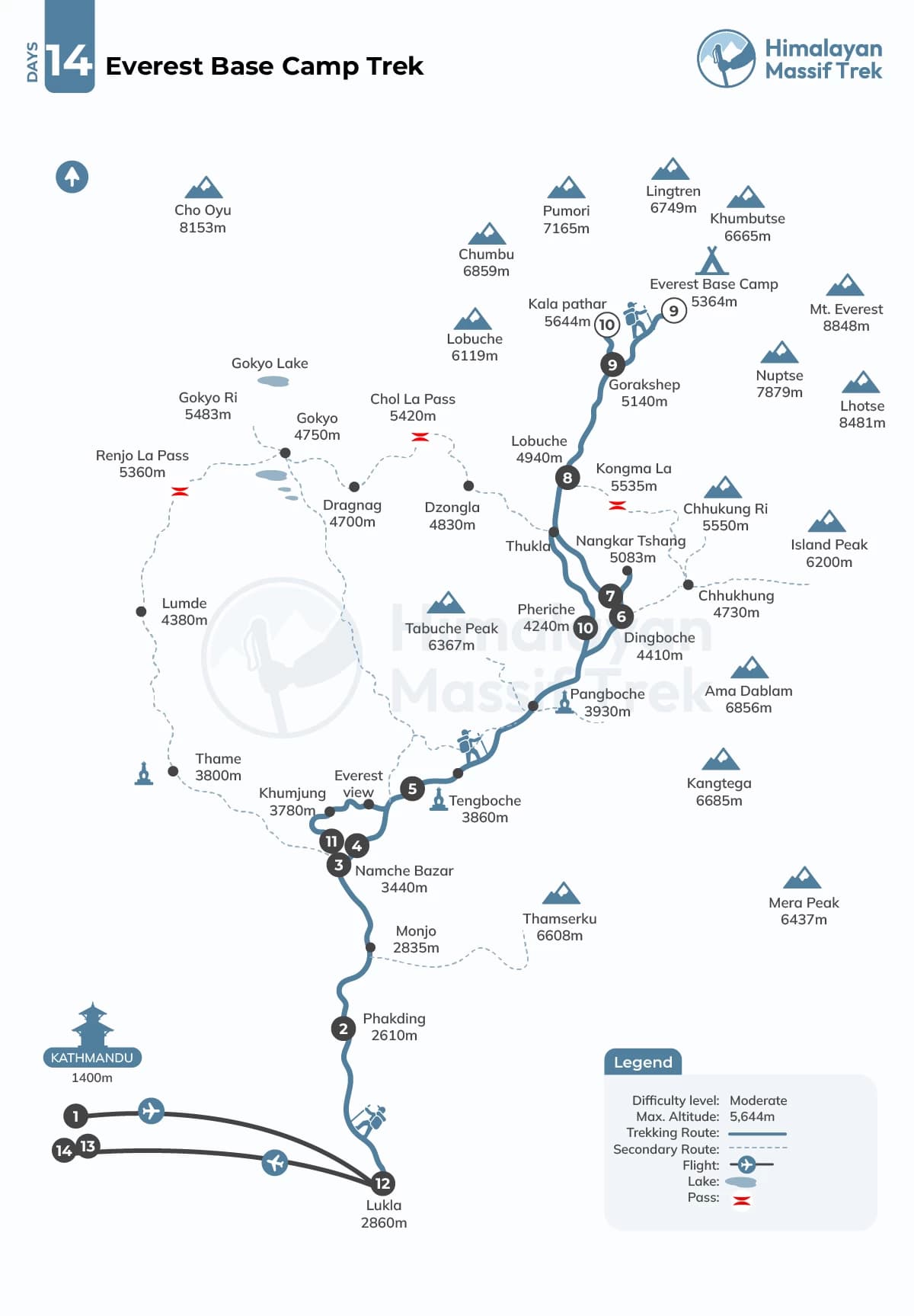

Cost Details
Accommodation:
- 2 Nights Hotel in Kathmandu ( 3-star hotel with BB plan)
- 11 nights comfortable lodge during the trek (Attached Bathroom in Namche-3 nights, Phakding-1 night, and Lukla-1 night)
Meals:
- 3 Standard meals a day ( Set of breakfast, Lunch and dinner)
- Farewell dinner in Kathmandu on the last night
Transportation and flights:
- International and Domestic airport pick up and drop
- Flight to Lukla from Kathmandu or Ramechhap and return
- Drop to Ramechhap and pick up from Ramechhap (during April, May, October and November)
Guide and porters:
- A highly experienced guide and an assistant guide if the group size is bigger than 6 people.
- A strong porter between two trekkers (he carries up to 20kg of baggage)
Permit and document:-
- Local government fees
- National park entry permit
Trekking gears:
- Sleeping bag and down jacket to use for the trek
- HMT T-shirt and duffel bag for free
- First aid kit
Miscellaneous:
- Salary, food and accommodation for guide and porters
- Government taxes and liabilities
- Any meals other than breakfast (for Kathmandu)
- Rescue & travel insurance, trip cancellation costs, accident or health emergency, evacuation, loss, theft, or damage to baggage and personal effects (We strongly advise you to take out personal travel insurance.)
- Additional night accommodation in Kathmandu
- Personal expenses (phone calls, internet, laundry, bar bills, battery recharge, extra porters, cold drinks, bottled or boiled water, hot shower, etc.)
- All alcoholic and non-alcoholic drinks including mineral water
- Nepal entry visa fee
- Tipping for guide and porters
To confirm your payment, a deposit payment is required, which is 30% of the total booking price. This deposit helps us secure permits, logistics, and other necessary arrangements for your trek.
We understand that plans can change, and we strive to be as flexible as possible. However, to cover operational costs, a cancellation fee applies. This is a percentage of your total booking price and is deducted from the deposit payment.
Cancellation Fees
Cancel 30% days before departure: 5% of the trip cost
Cancel between 10 to 30 days before departure: 10% of the trip cost
Cancel within 10 days of departure: 20% of the trip cost
If you need to cancel, please notify us as early as possible to reduce charges.
Rescheduling
Unexpected circumstances can disrupt travel plans, even if you still want to do the trip. To support our clients, we have generously waived all rescheduling fees. You can postpone and reschedule your trip at no additional cost, as long as the new departure date falls within one year of your original booking.
Upgrades
If you wish to upgrade your accommodation, transportation, or any other services not mentioned in the Trip Includes section, please be aware that these upgrades will incur additional costs. We can assist in arranging these options for you based on your preferences and availability.
Lukla Flights
Non-Refundable Flight Ticket: If you need helicopter evacuation or other means of transport due to altitude sickness or any other condition, your return flight ticket fare is non-refundable.
Refundable Flight Ticket: If the flight operator cancels your flight due to bad weather in Lukla, Kathmandu, or any other reason, your flight ticket fare is 100% refundable.
Dates & Availability
Private TripIf you don't find an appropriate date, you can propose a Preferred Departure Date, and we’ll ensure the trip runs as scheduled just for you.
Trip Gallery

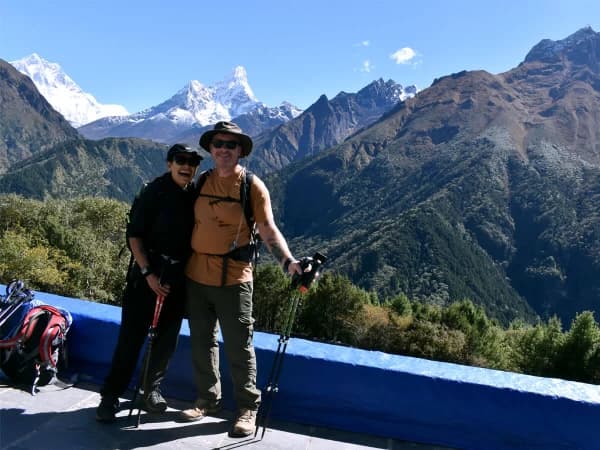

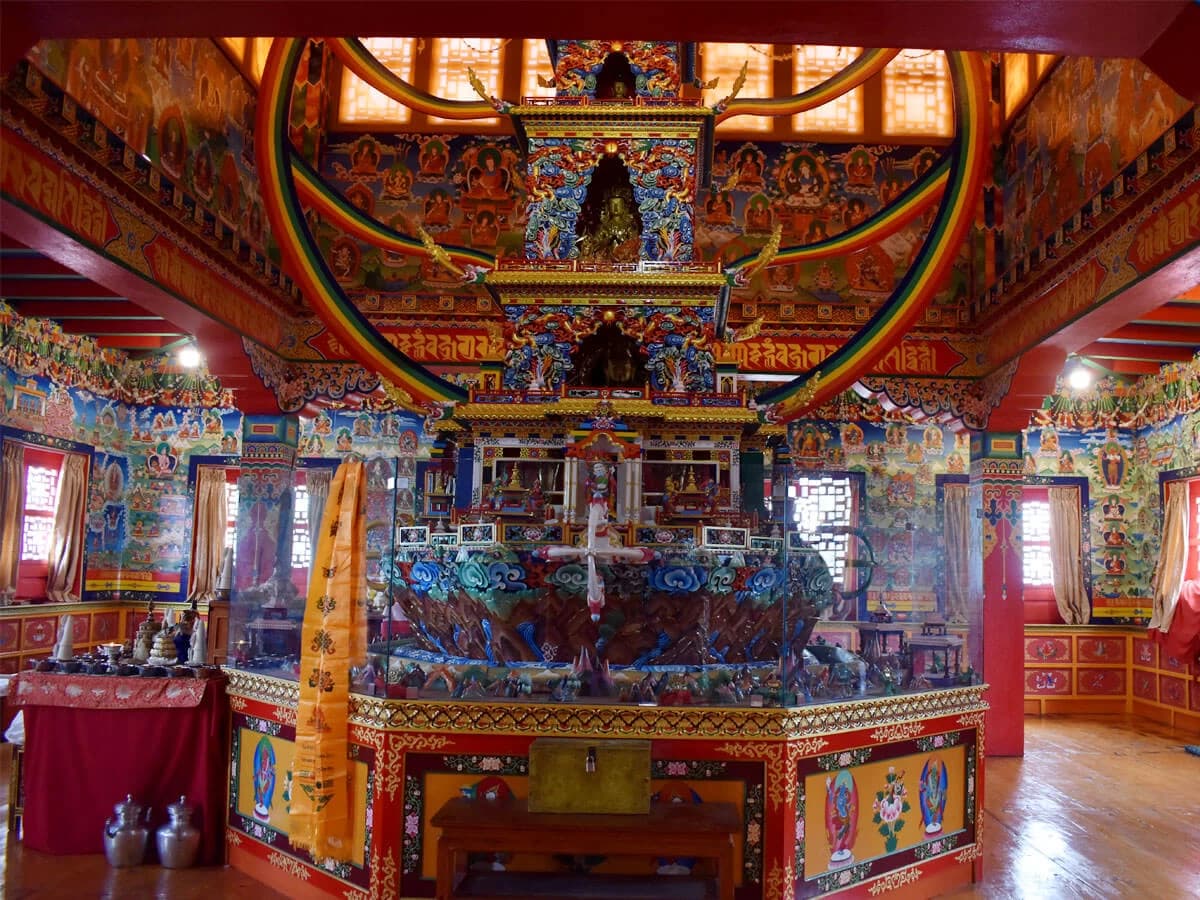

Essential Information
Best Time for the 14-Day Everest Base Camp Trekking
The ideal seasons for the Everest Base Camp Trek are spring (March to May) and autumn (September to November). These months offer stable weather, clear skies, and optimal trekking conditions.
In spring, the trails are beautiful with blooming rhododendrons and wildflowers, making the journey visually stunning. At this time of the year, daytime temperatures range between 10°C to 16°C (50°F to 60°F) at lower altitudes, while temperatures drop to -10°C to -15°C (14°F to 5°F) at higher altitudes like Gorak Shep. Overall, the weather, temperature, and visibility make spring a great time for the trek.
Autumn, on the other hand, provides crisp air and incredible mountain vistas after the monsoon rains have cleared away the dust and haze. Days are mild, with temperatures between 8°C and 14°C (46°F to 57°F), but nights can get equally cold at higher altitudes.
On the other hand, trekking during winter (December to February) is only possible for those prepared for extreme cold, as temperatures will plummet below -20°C (-4°F) at higher elevations. Regardless, the quieter trails may be appealing to some adventurers. Similarly, we do not recommend the monsoon season (June to August) due to heavy rainfall, slippery trails, and reduced visibility.
EBC Trek Difficulty
The Everest Base Camp Trek is a moderately challenging journey that requires physical fitness and mental preparation. While no technical climbing is involved, the trek’s high altitude, rugged terrain, and duration, covering approximately 130 kilometers (80 miles), make it demanding.
Daily trekking involves 5-8 hours of walking on uneven and steep trails. The air gets thinner as you go higher, and every other mile feels more challenging. Nonetheless, with careful planning, preparation, and support from our professional local guides, you can conquer the Everest Base Camp trail.
To prepare for the EBC trek, focus on cardio exercises like running, swimming, or cycling 3-4 times a week to build endurance. Strengthen your legs and core with squats, lunges, and planks to handle the challenging terrain. Practice hiking with a backpack weighing 7-10 kg (15-22 lbs) to simulate trek conditions.
Furthermore, acclimatization is important to prevent altitude sickness, so we include proper rest days on our itinerary. The Wilderness Medical Society recommends avoiding ascent to a sleeping elevation of ≥9,000 ft (≈2,750 m) in a single day; ascending at a rate of no greater than 1,650 ft (≈500 m) per night in sleeping elevation once above 9,800 ft (≈3,000 m); and allowing an extra night to acclimatize for every 3,300 ft (≈1,000 m) of sleeping elevation gain. With a licensed HMT guide, you’ll have expert support to monitor your health and ensure a safe pace.
Permits to Trek to Everest Base Camp
To trek to Everest Base Camp, you need two key permits: the Sagarmatha National Park Entry Permit and the Khumbu Pasang Lhamu Rural Municipality Permit. These permits, along with the TIMS card (Trekkers Information Management Systems), are mandatory and must be obtained before entering the region.
The Sagarmatha National Park Entry Permit allows access to the protected area, which can be obtained in Kathmandu or Monjo. The Khumbu Pasang Lhamu Rural Municipality Permit is required for all trekkers entering the Khumbu region and is issued at Lukla or Monjo.
Trekkers traveling with Himalayan Massif Trek will have their permits arranged by the company. Make sure you provide us with your passport and passport-sized photos, and the required fee.
To receive a permit, Nepal’s tourism regulations require all international travelers to have a valid passport with at least six months of validity and a Nepal entry visa. You can get a visa on arrival at Kathmandu’s Tribhuvan International Airport or through a Nepalese embassy in your home country. Please carry multiple copies of your travel documents and keep digital backups.
After we arrange the permits for you, make sure you carry these documents with you at all times during the trek, as there are checkpoints where you will need to present them. Your guide will supervise the permit checking on your behalf, making it more convenient.
Travel Insurance for Everest Base Camp and Kala Patthar Trekking
Having a good travel insurance policy saves an otherwise rewarding trip from going south. At Himalayan Massif Trek, we strongly recommend that you secure comprehensive travel insurance that specifically covers high-altitude trekking, medical emergencies, and helicopter evacuations.
In the event of a serious health condition or altitude-related issues during your Everest Base Camp trek, helicopter evacuation is often the only viable solution. Helicopters can quickly access higher altitudes and transport trekkers to medical facilities in Kathmandu or Lukla, where they can receive the urgent care they need. This quick evacuation often proves life-saving, which is why we recommend you have insurance that covers helicopter rescues, ensuring you have immediate access to help if necessary.
For travelers from the United States, we recommend UnitedHealthcare Global, which offers robust plans, including emergency medical evacuation and 24/7 global assistance. European trekkers may opt for Allianz Global Assistance or Europe Assist, both of which provide excellent coverage for Nepal trekking, including helicopter evacuations and flexible claim processes.
Similarly, Australian travelers will benefit from Cover-More Travel Insurance, which provides specialized packages for high-altitude adventures and extensive medical coverage. World Nomads Travel Insurance is another reliable choice, offering worldwide coverage, including trekking, and the convenience of purchasing or extending policies online even after your trip begins.
Review the terms and policies of your chosen provider thoroughly to ensure your plan meets your specific needs, including coverage for medical expenses, cancellations, and unexpected disruptions.
Environmental Responsibility and Waste Management on the Everest Trail
At Himalayan Massif Trek, we prioritize environmental responsibility and waste management to help preserve the pristine beauty of the Everest region. The impact of trekking on the environment is significant, and we are committed to minimizing our footprint by encouraging sustainable practices.
Our trekkers are instructed to carry reusable water bottles and avoid single-use plastics, reducing waste on the trails. We also ensure that all waste, including food wrappers and other non-biodegradable items, is properly disposed of and taken back to the city for recycling.
In line with local initiatives, we actively support the Sagarmatha Next program, which is dedicated to the conservation and sustainable development of the Everest region. We also participate in trash collection campaigns and partner with local organizations to encourage eco-friendly trekking practices, such as using biodegradable products and supporting eco-lodges.
Our goal is to ensure that the stunning landscapes of Everest Base Camp remain protected for future generations to enjoy. We encourage all our trekkers to adopt a responsible approach to waste management, helping us in our shared mission of environmental stewardship.
Currency and Miscellaneous Expenses Along the Khumbu Trail
The currency used in Nepal is the Nepalese Rupee (NPR). You won’t find ATMs at higher altitudes, so withdraw cash in Kathmandu before you begin your trek.
Along the way, you'll encounter several costs other than those covered by your booked trip. You will need to budget for extra services such as charging your electronics (which can cost NPR 200–500 per hour), hiring a hot shower, or purchasing snacks and souvenirs.
Carry sufficient cash for the entire trek, as there are limited opportunities to withdraw money once you’re on the trail. We recommend carrying money equivalent to USD 20 per day in Nepalese currency. Cards are rarely accepted in the villages along the trail, and you’ll need cash for most purchases.
Everest Base Camp Trek Equipment List
FAQs
No, you don’t need to pay the full amount upfront. You can book your trek in advance with a small deposit, and the remaining balance can be paid upon arrival.
You can pay the remaining amount in cash (USD, NPR, or other major currencies) or via bank transfer/credit card at our office before the trek starts. Some payment methods may include an additional transaction fee.
Yes, you can reserve your trek and pay a deposit to confirm your spot. However, full payment is required before the trek begins.
Unfortunately, we do not offer refunds for incomplete treks because accommodation, guide scheduling, and other arrangements are made in advance. However, if you need to return early due to illness or other reasons, we will assist in arranging transportation and accommodation. We highly recommend travel insurance for such situations.
Yes! We offer custom itineraries based on your preferences, fitness level, and time constraints. You can modify trekking days, rest stops, and additional side trips like Gokyo Lakes or Island Peak climbing.
To book, you can fill out our online form or contact us directly. After confirming availability, you need to make a deposit to secure your spot. We then provide detailed trip information and preparation guidelines.
The highest point of the Everest Base Camp Trek is Kala Patthar 5,644 m (18,519 ft), which offers stunning panoramic views of Mount Everest. The base camp itself sits at 5,364m (17,598ft).
Key Sherpa villages along the trail include:
- Lukla (2,860m) – The gateway to the trek.
- Phakding (2,610m) – A small village on the Dudh Koshi River.
- Namche Bazaar (3,440m) – The main trading hub and acclimatization stop.
- Tengboche (3,867m) – Home to the famous Tengboche Monastery.
- Dingboche (4,410m) – A scenic acclimatization village.
- Lobuche (4,940m) & Gorak Shep (5,164m) – The final stops before reaching Everest Base Camp.
The best times for the Everest Base Camp trek are:
- Spring (March-May): Clear skies, blooming rhododendrons, and moderate temperatures.
- Autumn (September-November): Stable weather, excellent visibility, and comfortable trekking conditions.
Winter and monsoon seasons are possible but come with challenges like extreme cold and heavy rainfall.
The trek follows a well-established trail through the Khumbu region, featuring suspension bridges, pine forests, and glacial moraines. Expect steep ascents, rocky terrain, and gradual acclimatization stops.
While Yetis remain a mythical legend, the chances of spotting a snow leopard are extremely rare since they stay in remote high-altitude areas. However, trekkers often see Himalayan tahr, musk deer, pheasants, and yaks along the route. The Sagarmatha National Park is rich in biodiversity, so keep an eye out for unique Himalayan wildlife!
Yes, beginners can complete the trek with proper preparation and a slow, steady pace. We recommend training at least a few months in advance with long hikes and carrying a backpack to simulate the trek conditions. Acclimatization days in the itinerary will also help your body adjust to the altitude.
You should have a moderate to high level of fitness for the Everest Base Camp trek. While you don’t need to be an athlete, regular cardio exercises like hiking, running, or cycling will help prepare you. Strength training and endurance exercises are also beneficial.
The trekking pace is slow and steady, allowing time for acclimatization and enjoyment of the scenery. On average, you will walk about 5-7 hours per day, covering 8-12 km at a manageable pace. The pace is adjusted based on group fitness levels and weather conditions.
Yes, the trek is safe for female travelers. Our guides and porters ensure a secure and comfortable journey. Nepal is known for its hospitality, and solo female trekkers often find the trek welcoming.
If you feel unwell, inform your guide immediately. Mild symptoms like headaches or nausea are common and can often be managed with rest, hydration, and proper acclimatization. If symptoms worsen, descent is the best option.
Our itinerary includes acclimatization days to minimize altitude sickness. Our guides monitor symptoms daily and take necessary precautions. In case of severe altitude sickness, we arrange for an emergency descent or evacuation.
Basic medical facilities are available in Lukla, Namche Bazaar, and Pheriche. For emergencies, the Himalayan Rescue Association (HRA) clinic in Pheriche provides medical assistance. Serious cases may require helicopter evacuation to Kathmandu.
Yes, our guides are first-aid certified and trained in (AND have experience dealing with) high-altitude sickness management. We carry a first-aid kit, oxygen cylinders, and pulse oximeters to monitor oxygen levels daily.
If an emergency occurs, our guide will assess the situation and take appropriate action, including first aid, arranging for evacuation, or calling a rescue helicopter if necessary. We recommend travel insurance covering high-altitude evacuation.
- Acclimatize properly – Follow the itinerary and take rest days.
- Stay hydrated – Drink at least 3-4 liters of water daily.
- Walk at a steady pace – Avoid overexertion.
- Eat well – Maintain a high-carbohydrate diet.
- Avoid alcohol and smoking – These can worsen symptoms.
- Consider altitude medication – Consult your doctor about Diamox (Acetazolamide) for prevention.
Yes, you can and may have to stay an extra night in Kathmandu before the trip. Trekkers can also choose to stay in Kathmandu after the trip for more exploration. However, additional nights (for any reason whatsoever) are not included in the trek package and will require an extra charge.
In lower-altitude villages like Lukla, Phakding, and Namche Bazaar, some teahouses offer private bathrooms with attached toilets. However, as you go higher, most accommodations have shared toilets.
You will stay in teahouses (lodges) along the trail, which offer basic but comfortable rooms with twin beds, blankets, and pillows. In Kathmandu, you will stay in a 3-star or equivalent hotel before and after the trek.
Yes, private rooms are available in Kathmandu upon request. Along the trek, private rooms can be arranged at lower altitudes, but at higher elevations like Gorak Shep, availability is limited, especially during peak seasons.
Teahouses offer a variety of Nepali, Tibetan, and Western dishes, including:
- Dal Bhat (Rice, lentils, vegetables)
- Noodles, pasta, and soups
- Eggs, pancakes, and porridge for breakfast
- Momo (dumplings) and fried rice
Most menu items on the trail are carbohydrate-rich to keep your energy levels high.
Yes, you can get boiled or hot drinking water at teahouses, but it costs extra, usually $1-$3 per liter, depending on altitude.
Tap or stream water is not safe to drink without treatment. You should:
- Bring purification tablets or a water filter
- Refill at the teahouses where they provide boiled water
- Use bottled water if necessary (but it's costly at high altitudes)
Yes, vegetarian meals are widely available on the Everest trail. Many trekkers prefer vegetarian options to avoid digestive issues at high altitudes.
If you have allergies or dietary restrictions, inform us in advance. While teahouses can adjust meals, cross-contamination risks exist in remote areas. Bringing your own snacks for specific needs is recommended.
Regular flights to Lukla operate from Ramechhap (Manthali) Airport during peak seasons and from Kathmandu in the off-season. If you prefer, you can book a helicopter flight instead of a regular flight, either shared or private.
The weight limit for Lukla flights is 15 kg (33 lbs) per person, including both checked luggage (10 kg) and hand carry (5 kg). Excess baggage will require an additional fee.
Lukla flights are weather-dependent and may be delayed or canceled. In such cases, options include:
- Waiting for the next available flight
- Taking a helicopter (if available, at an extra cost)
- Rearranging trek dates
We recommend keeping buffer days in your schedule.
Yes, travel insurance is mandatory for the Everest Base Camp trek. It should cover:
- High-altitude trekking (above 5,000m)
- Helicopter evacuation and medical emergencies
- Trip cancellations and delays
Yes, you can get a tourist visa on arrival at Tribhuvan International Airport (TIA) in Kathmandu. Fees:
- 15 days – $30
- 30 days – $50
- 90 days – $125
You need a passport valid for at least six months and a passport-sized photo (or use the on-site photo booth).
- Valid passport (at least 6 months validity)
- Nepal visa (on arrival or pre-arranged)
- Trekking permits: TIMS, Khumbu Rural Municipality Permit, Sagarmatha National Park Entry
- Travel insurance details
Yes, mobile network coverage is available but limited. NCELL and Nepal Telecom (NTC) provide coverage in most areas, but the signal is weak or unavailable at higher altitudes like Dingboche, Lobuche, and Gorak Shep.
Yes, you can charge your devices at teahouses, but it costs extra (around $2-$5 per hour). Bringing a power bank or solar charger is recommended.
- Wi-Fi is available in most teahouses but is slow and expensive ($3-$10 per hour).
- Everest Link provides prepaid Wi-Fi cards that work in multiple villages.
- Mobile data (3G/4G) from NCELL or NTC works in some areas but is unreliable at higher altitudes.
The last reliable ATMs are in Namche Bazaar, but they can be unreliable or have high fees. Bring enough cash from Kathmandu to cover extra expenses during the trek.
- 1 guide is assigned for every 6-8 trekkers.
- 1 porter usually carries luggage for 2 trekkers, with a weight limit of 15-20 kg per porter.
All our trek guides have prior experience trekking in the Everest region. They operate trips to the same trail multiple times in a trekking season, and hence are well-equipped and knowledgeable to deal with any and all circumstances on the trail.
Yes, you can:
- Shorten the trek by taking a helicopter back from Gorak Shep or Lukla.
- Extend the trek by adding Gokyo Lakes, Three Passes, or other routes.
Yes, teahouses and small shops sell chocolates, energy bars, biscuits, soft drinks, and even beer, but prices increase with altitude.
- In lower villages, some teahouses have Western-style toilets.
- At higher altitudes, most toilets are squat-style and shared.
- Some locations have outhouses or pit toilets.
- Hot showers are available in lower-altitude teahouses ($3-$8 per shower).
- At higher altitudes, only bucket showers (warm water in a bucket) are available for a fee.
- Some teahouses offer basic laundry services at lower altitudes (extra charge).
- At higher altitudes, laundry is not available, and clothes must be hand-washed.
I. Expertise and Local Knowledge
When you book the trek with Himalayan Massif Trek, you're choosing a team of experienced guides who have in-depth knowledge of the Everest region. The guides are locals who know the culture, terrain, and trails better than anyone else. With decades of trekking expertise in the Himalayan belt, they will ensure you have a safe and enriching journey throughout your trek.
II. Authentic Local Experiences
We offer you the chance to experience authentic Sherpa villages like Namche, Tengboche, Dingboche, and Gorakshep. Along the way, you'll enjoy traditional Sherpa meals, providing you with a true taste of local culture. You’ll also gain insights into the traditions, lifestyle, and hospitality of the people from the Everest region. Hence, this makes your trek feel like more than just a hike - it’s a cultural adventure.
III. Value for Money
We offer competitive prices with no hidden costs. Everything is included, from your permits and comfortable accommodations to your delicious meals. Plus, we have special discounts for groups and repeat travelers.
IV. Environmental Responsibility
Our company is committed to environmental responsibility, ensuring that trekking in the Everest region has minimal impact on the environment. By using eco-friendly trekking practices and supporting local suppliers, we help preserve the beauty of the Himalayas. We also prioritize sustainable travel, ensuring that local communities and the stunning landscape remain protected for future generations.
- Expertise in High-Altitude Trekking Adventures
- Over 18 Years of Experience in The Himalayas
- Authorized and Reliable Trekking Partner
- Trusted by Thousands of Adventurers Worldwide
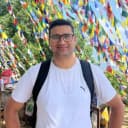
The EBC trek was an unforgettable adventure. The landscapes were breathtaking, and the camaraderie among the group was amazing. The guides were attentive and made...
Reaching Everest Base Camp was a dream come true. The trek was challenging but incredibly rewarding. The lodges were comfortable, and the food was great....
The EBC trek was everything I hoped for and more. The scenery was stunning, and the cultural experiences along the way were enriching. Our guide,...

